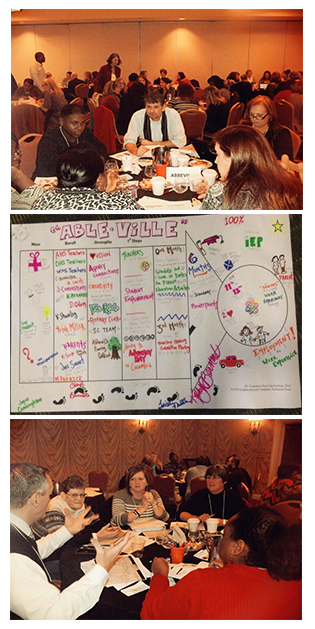The Transition Alliance of SC: Building Capacity Statewide by Scaling Up Local Interagency Teams (SC UCEDD)
April 28, 2015

|
Joy Godshall Ivester, M.Ed. and
Kinsey Carlson-Britting, MSW, MPH
Center for Disability Resources (UCEDD)
University of South Carolina, School of Medicine
South Carolina's UCEDD, the Center for Disability Resources (CDR) at the University of South Carolina's School of Medicine, is spearheading a statewide initiative to improve secondary transition programming and practices for students with intellectual or developmental disabilities. The CDR is partnering in this effort with other state stakeholders via the Transition Alliance of South Carolina (TASC), the statewide interagency transition team. Utilizing funding and support from TASC partners, project staff housed at the Center for Disability Resources has initiated the development of an infrastructure to support local interagency transition teams as they increase their capacity to collaboratively and effectively serve young adults with ID/DD who are transitioning from high school to adult-life.
The Transition Alliance has been in existence for four years and works together to build capacity for transition programming at the state level, while also serving as a bridge to local communities in South Carolina. The partnership consists of and maintains a Memorandum of Understanding with the following members: Able SC, PRO Parents of SC, the SC Department of Disabilities and Special Needs (DDSN), the SC Developmental Disabilities Council (DDC), Lexington School District Five, SC Vocational Rehabilitation Department (SCVRD), Family Connection of South Carolina, USC's Center for Disability Resources (CDR), USC's Department of Educational Studies, Francis Marion University, and the SC Department of Education (SDE). In addition, the membership is undergoing a period of growth and will soon add the following additional members: Commission for the Blind, SC Department of Mental Health (DMH), Walton Options, SC's Assistive Technology Program (SCATP), SC Department of Employment and Workforce (DEW), and Protection and Advocacy for People with Disabilities, Inc. (P&A).
Currently, forty-two interagency teams, each representing one local school district, are participating in Alliance activities. The Alliance work was initiated in May of 2014 during a one-day planning institute headlined by Dr. Sharon DeFur, secondary transition expert and Professor at the College of William and Mary, and then bolstered in November of 2014, when the local teams participated in the Statewide Interagency Transition Conference in Charleston, SC.
During that two-day conference event, which was co-sponsored by numerous Alliance partners, participants had the opportunity to learn about secondary transition evidence-based and promising practices and how specific local communities are operationalizing those practices in South Carolina. In addition, participating interagency teams engaged in facilitated strategic planning sessions led by Dr. Mary Morningstar, Director of the Transition Coalition at the University of Kansas and Meghan Trowbridge, Assistant Director of the Center for Disability Resources (SC-UCEDD).
Using the PATH (Planning Alternatives Tomorrow with Hope) tool as a framework, session leaders facilitated the construction of individualized local strategic plans focused on building capacity in transition and employment planning and programming for youth and young adults with disabilities. Although used as an organizational planning tool with the local interagency teams, the PATH planning process has traditionally been employed as a person centered planning tool for individuals. Through the PATH process, teams mapped out their long-terms goals and then gradually broke those goals down into more immediate steps. By the end of the planning sessions, not only were immediate steps identified, but responsibilities were assigned, and deadlines for completion were established. (See local PATH team example below).
Strategic planning is a key component of this work. However, effective implementation of evidence based practices is the gateway for success. The Center for Disability Resources is partnering with the SC Department of Education, SC DDSN, the SC DD Council, and other Alliance partners and consultants to coordinate and deliver the resources needed for the local teams to effectively implement the individual goals they prioritized during the two-day conference. Assistance is being provided to local teams via a multi-tier system that includes training, technical assistance, provision of resources, and various web-based networking and training tools. In addition, a framework that capitalizes on the cross-team (community) sharing of strengths, experiences, and resources of local districts that are implementing evidence-based practices will build local and state capacity through the creation of a network of local community experts.
The Transition Alliance staff and partners consider this merely the beginning stage of the construction of a novel, yet highly functional, progressive, and replicable method of building support for local communities from the top (state-level) down (community-level) and perhaps more-importantly, across local teams and practitioners/stakeholders. We believe that through capitalizing on the momentum and resources of our state partners, and coupling those with the resources at the CDR, we have the potential to recreate the way assistance is provided to local secondary transition stakeholders (via the local interagency transition teams), building a system of support that includes partnering with state agencies to provide the support for local systems.
To learn more about this initiative, contact Joy Ivester, Program Director, CDR Secondary Transition Programs.







